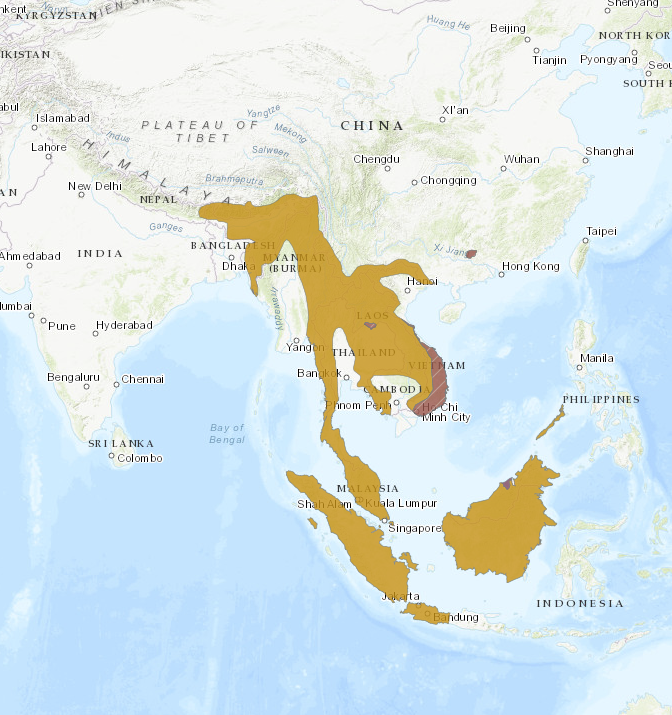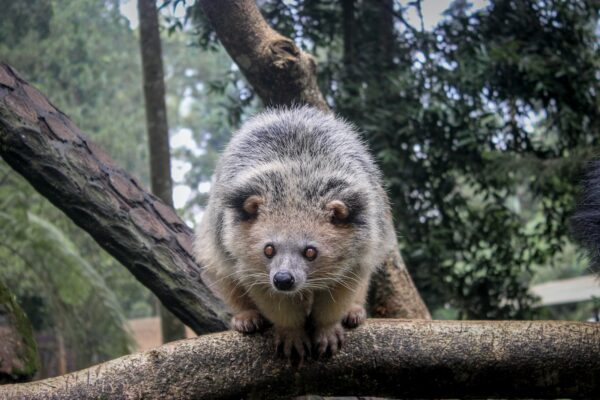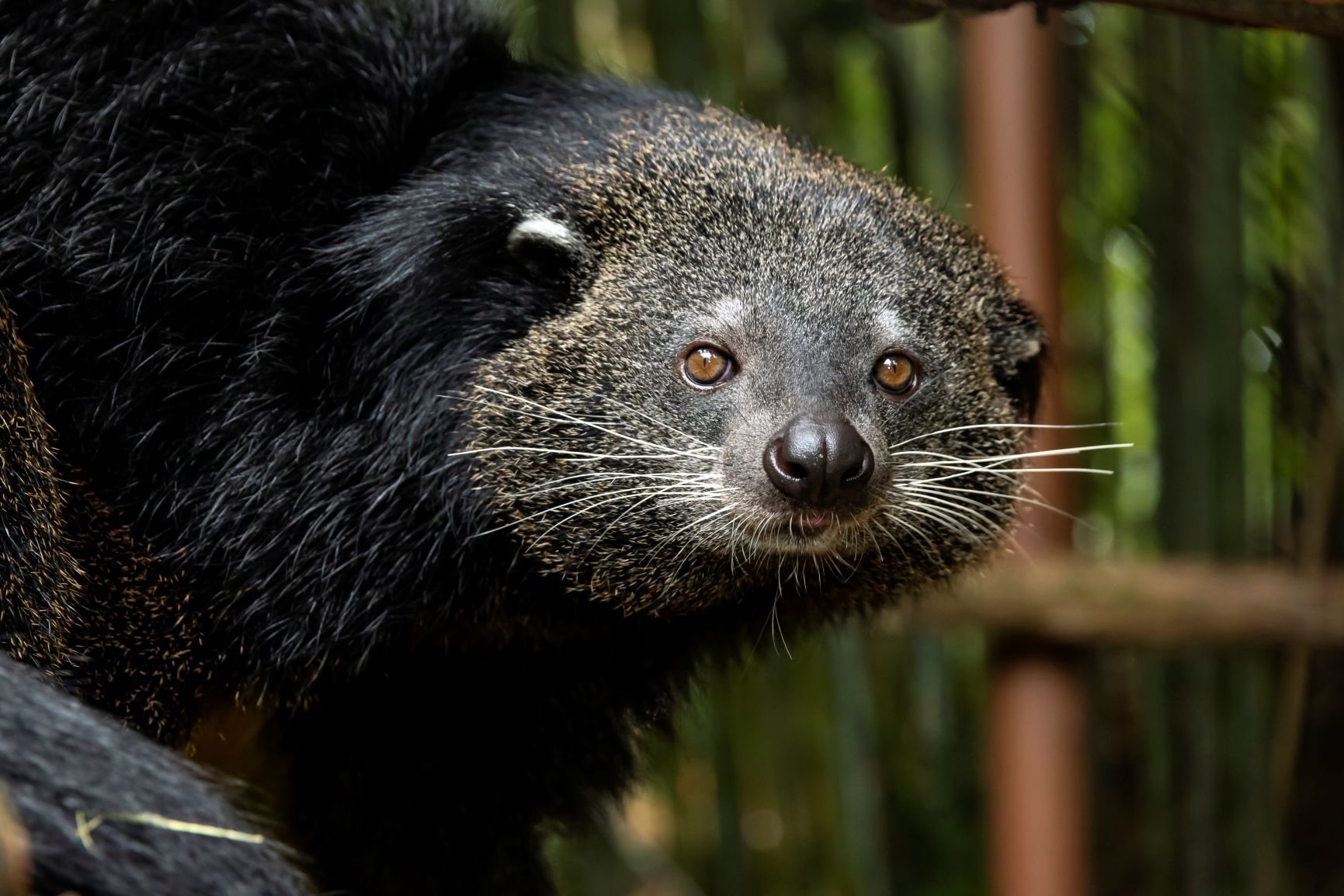Is it a bear? Is it a cat? No, it’s the binturong, an intriguing Southeast Asian mammal with a vital role in its ecosystem. With a fifth limb-like tail and vital ecological functions, the binturong’s unique traits are fascinating yet under threat. This article delves into the life and challenges of the binturong, shedding light on a species shrouded in mystery.
Learn more by reading our ultimate profile of the Binturong
Key Takeaways
- The binturong, known as ‘bear weasel’, is a unique and elusive mammal native to Southeast Asia, with significant ecological roles such as seed dispersal due to their frugivorous diet.
- Binturongs are facing major conservation challenges, including habitat destruction, hunting, and the wildlife trade. They are listed as ‘Vulnerable’; efforts to protect them involve education, community awareness, and international laws like CITES.
- Zoos support binturong conservation through funding, public education, and by providing care and expertise for the species, while World Binturong Day raises global awareness to aid in protection efforts.
Mystique of the Binturong
The binturong, commonly mislabeled as a bearcat, defies easy classification. It is neither a bear nor a cat, this creature belongs to its unique niche in the animal kingdom, thriving in the dense forests of Southeast Asia.
The name ‘binturong’ is a testament to the animal’s enigmatic nature, derived from a language far removed from scientific circles. Yet, beneath the surface of this mystique lies a fascinating creature, with peculiar habits and an integral role in its habitat’s ecology.
The Essence of the Name
The binturong’s scientific journey began with Thomas Stamford Raffles, who first coined ‘Viverra binturong’ in 1822. Today, this creature is classified under the genus Arctictis, with ‘Arctictis binturong’ as its scientific moniker. This name intriguingly translates to ‘bear weasel’—in fact, “arctictis means bear weasel.”
In the forests of Borneo, the local dialects have shaped the name ‘binturong’ from ‘ma-tuRun’, a term that echoes through the variations of ‘benturong’ and ‘tenturun’ in regional tongues.
Appearance and Adaptations
Enveloped in a thick coat of coarse black hair, the binturong’s appearance is as striking as its adaptations are practical. This mammal’s size is considerable, with adults measuring up to 38 inches in body length, their statuesque tails adding another 35 inches. The tail is prehensile, curling inward and acting as a fifth limb, an evolutionary marvel that aids the binturong’s arboreal lifestyle.
It boasts half-retractable claws and front paws that can rotate 360 degrees, allowing for a climbing agility that is as remarkable as it is necessary within its forested realm.
Sensory Peculiarities
The binturong’s sensory capabilities are as distinctive as its appearance. With starkly white vibrissae, or whiskers, set against its dark fur, this creature relies on touch and spatial awareness to navigate the complex layers of its habitat. Edged with white, the binturong’s ears are tipped with tufts of black hair, suggesting their importance in sensory perception.
These features, alongside other facial characteristics, contribute to the binturong’s peculiar radiated circle of sensory input, enabling it to engage with its environment in a way that is uniquely its own.
Diet of the Tree Dweller
Climbing skillfully through the forest canopy, the binturong is a consummate forager, its diet primarily composed of the abundant fruits that dangle from the branches. Figs, in particular, are a favored delicacy, playing a pivotal role in the binturong’s nutrition and the health of the forests it inhabits.
As a frugivore, this tree dweller is vital for seed dispersal, ensuring the propagation of the very trees that provide it shelter and sustenance.
Foraging Strategies
The binturong’s foraging strategies are as complex as its diet is varied. In addition to fruits, it also consumes:
A rapid digestive transit time supports a high intake of these low-nitrogen foods, a necessity given the binturong’s frugivorous habits.
The absence of fermentation for structural polysaccharides in its digestive system indicates a reliance on simpler carbohydrates for energy. This strategy may also involve lowering its basal metabolic rate to manage energy requirements efficiently.
Feeding Habits in Captivity
The binturong’s diet must be adjusted in captivity to ensure its health and well-being. Under human care, these animals are often provided with meat, additional fruits, and mineral supplements to replicate the nutritional diversity they would experience in the wild. This careful attention to dietary balance is critical, as captive binturongs require specialized diets that can differ significantly from their natural foraging habits.
Habitats Across Horizons
The binturong’s geographical range is as broad as the variety of habitats it calls home. Stretching across South and Southeast Asia, these creatures are found from India’s forested plains to Laos’s extensive evergreen forests.
Their adaptability to various forest types, including extensive evergreen forest and secondary forest, is a testament to their resilience and is essential for the survival of their species in areas like kakoi reserved forests.
Forest Diversity
 Diversity is a hallmark of the binturong’s habitat preferences. They can be found in:
Diversity is a hallmark of the binturong’s habitat preferences. They can be found in:
- Dense rainforests with towering trees
- Scrub forests
- Hill forests of northeastern India
- Secondary forests surrounding Malaysian palm estates
- Evergreen forests of Laos
Each ecosystem, including the tall forest, secondary lowland forest, and the secondary forest surrounding, offers the sturdy trees and good cover essential for their climbing lifestyle.
Conservation Challenges
Despite their adaptability, binturongs face significant conservation challenges, particularly from habitat loss due to deforestation and logging. The fragmentation of their natural environments is a critical threat, especially in the lowlands of the Sundaic region where binturong occurs. Efforts to reintroduce confiscated binturongs into the wild are hindered by insufficient data on their origins, a gap being bridged through the development of genomic tools and genetic tracking projects.
Collaborative conservation strategies are thus essential, involving zoos, researchers, and organizations united in the pursuit of education, community awareness, and research.
Solitary Yet Social: Binturong Behaviors
The binturong’s behaviors are a blend of solitude and occasional social interaction. These solitary animals tend to avoid contact with their kin, save for the critical mating periods. However, maternal bonds are strong; mother binturongs nurture their offspring until they reach sexual maturity, highlighting a social aspect within the confines of family.
Climbing Skills
 Arboreal expertise is central to the binturong’s survival. With stout legs and a gradually tapering tail that curls inwards, these animals are adept climbers, using their prehensile tail to navigate and stabilize themselves among the treetops.
Arboreal expertise is central to the binturong’s survival. With stout legs and a gradually tapering tail that curls inwards, these animals are adept climbers, using their prehensile tail to navigate and stabilize themselves among the treetops.
Rather than leaping between trees, binturongs often descend to the ground to move to new areas, employing their unique ability to rotate their hind legs backward for a head-first descent.
Reproductive Life
In the realm of reproduction, binturongs are patient. Here are some key facts:
- Females reach sexual maturity around 30 months
- Males are ready to mate approximately every 28 months
- The litter size is typically two
- The young exhibit a unique behavior known as ‘teat ownership,’ each offspring claims a specific teat for nursing, an arrangement that can lead to disputes among siblings.
Threats and Conservation Efforts
The binturong’s existence is under threat, classified as ‘Vulnerable’ on the IUCN Red List, with variations in status across different regions. The primary dangers they face include:
- Habitat loss
- Hunting
- The pet trade
- The fur and meat trades
- Poaching
Conservation efforts are multifaceted, with binturongs listed under CITES and protected under Schedule I to mitigate threats and prevent further declining population trends.
Role in Awareness
Raising awareness is a pivotal component of binturong conservation. Since its inception in 2015, World Binturong Day has been instrumental in drawing global attention to these animals, encouraging measures to protect their natural habitats. This annual event is crucial in educating the public, especially the youth, about the importance of binturong conservation and inspiring actions to ensure their continued survival.
The Zoo Connection
Zoos play a significant role in the conservation network for binturongs. Through funding field initiatives, educating the public, and providing expert knowledge, zoos contribute to the understanding and development of conservation programs for the species. This partnership is crucial in addressing the complex challenges of binturong conservation, from combating habitat loss to mitigating the impacts of the pet trade.
Summary
In conclusion, the binturong is a creature of wonder and complexity, with its intriguing name, distinctive appearance, and peculiar behaviors. As stewards of the natural world, it is our responsibility to ensure the survival of this unique species. The conservation challenges the binturong faces are significant, but with education, awareness, and global cooperation, there is hope for their future. May the continued efforts of researchers, conservationists, and wildlife enthusiasts alike help secure a place for the binturong in the wilds of Asia for generations to come.
Frequently Asked Questions
Are binturong aggressive?
Binturongs are normally shy, but can become very aggressive when harassed, using their powerful jaws and teeth in self-defense. Be cautious when interacting with them.
Can you have a binturong as a pet?
No, binturongs are fierce wild animals and do not make good pets.
What does the name ‘Arctictis binturong’ mean?
The name ‘Arctictis binturong’ means ‘bear-weasel’ in Greek and ‘ma-tuRun’ in the Western Malayo-Polynesian language.
What is the binturong’s primary diet in the wild?
In the wild, binturongs primarily eat fruits, especially figs, which are crucial for seed dispersal in their forest habitats. They also consume insects, birds, fish, rodents, and occasionally carrion.
How do binturongs contribute to their forest environments?
Binturongs contribute to their forest environments by playing a crucial role in seed dispersal through their consumption of figs and other fruits, which aids in the propagation of trees and maintaining forest health.


